International Journal of Intelligent Systems and Applications @ijisa
Статьи журнала - International Journal of Intelligent Systems and Applications
Все статьи: 1214
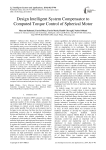
Design Intelligent System Compensator to Computed Torque Control of Spherical Motor
Статья научная
Spherical three Degree-of- Freedom (DOF) is controlled by model-base fuzzy computed torque controller. The spherical motor has three revolute joints allowing the corresponding parts to move horizontally and vertically. When developing a controller using conventional control methodology (e.g., feedback linearization methodology), a design scheme has to be produced, usually based on a system’s dynamic model. The work outline in this research utilizes soft computing applied to new conventional controller to address these methodology issues. Computed torque controller (CTC) is influential nonlinear controllers to certain systems which this method is based on compute the required arm torque using nonlinear feedback control law. When all dynamic and physical parameters are known, CTC works superbly; practically a large amount of systems have uncertainties and fuzzy feedback Inference Engine (FIS) is used to reduce this kind of limitation. Fuzzy logic provides functional capability without the use of a system dynamic model and has the characteristics suitable for capturing the approximate, varying values found in a MATLAB based area. Based on this research model- base fuzzy computed torque controller applied to spherical motor is presented to have a stable and robust nonlinear controller and have a good result compared with conventional and pure fuzzy logic controllers.
Бесплатно

Design Minimum Rule-Base Fuzzy Inference Nonlinear Controller for Second Order Nonlinear System
Статья научная
This research is focused on proposed minimum rule base PID computed torque algorithms with application to continuum robot manipulator. The stability of the closed-loop system is proved mathematically based on the Lyapunov method. Classical Computed Torque Controller (CTC) is robust to control model partly uncertainties and external disturbances. This controller is one of the significant nonlinear methodologies; according to the nonlinear dynamic formulation. One of the main targets in this research is increase the robustness based on the artificial intelligence methodology. Classical computed torque control has difficulty in handling unstructured model uncertainties. One can overcome this problem by combining a computed torque controller and artificial intelligence (e.g. fuzzy logic). To approximate a time-varying nonlinear dynamic system, a fuzzy system requires a large amount of fuzzy rule base. This large number of fuzzy rules will cause a high computation load. To reduce the number of rule base this research is focused on the PD like fuzzy plus integral methodology. This method is applied to continuum robot manipulator to have the best performance.
Бесплатно
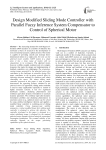
Статья научная
The increasing demand for multi-degree-of-freedom (DOF) actuators in a number of industries has motivated a flurry of research in the development of non-conventional actuators, spherical motor. This motor is capable of providing smooth and isotropic three-dimensional motion in a single joint. Not only can the spherical motor combine 3-DOF motion in a single joint, it has a large range of motion with no singularities in its workspace. The spherical motor, however, exhibits coupled, nonlinear and very complex dynamics that make the design and implementation of feedback controllers very challenging. The orientation-varying torque generated by the spherical motor also contributes to the challenges in controller design. This paper contributes to the on-going research effort by exploring alternate methods for nonlinear and robust controlling the motor. The robust sliding mode controller proposed in this paper is used to further demonstrate the appealing features exhibited by the spherical motor. In opposition, sliding mode controller is used in many applications especially to control of highly uncertain systems; it has two significant drawbacks namely; chattering phenomenon and nonlinear equivalent dynamic formulation in uncertain dynamic parameter. The nonlinear equivalent dynamic formulation problem and chattering phenomenon in uncertain system (e.g., spherical motor) can be solved by using artificial intelligence theorem and applied a modified linear controller to switching part of sliding mode controller. Using Lyapunov-type stability arguments, a robust modified linear fuzzy sliding mode controller is designed to achieve this objective. The controller developed in this paper is designed in a robust stabilizing torque is designed for the nominal spherical motor dynamics derived using the constrained Lagrangian formulation. The eventual stability of the controller depends on the torque generating capabilities of the spherical motor.
Бесплатно
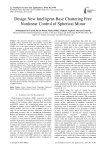
Design New Intelligent-Base Chattering Free Nonlinear Control of Spherical Motor
Статья научная
The main four objectives to design controllers are: stability, robust, minimum error and reliability. Linear PID controller is model-free controller and this controller is not reliable. One of the robust nonlinear controller to control of nonlinear systems is sliding mode controller (SMC). Sliding mode controller (SMC) is robust conventional nonlinear controller in a partly uncertain dynamic system’s parameters. Sliding mode controller is divided into two main sub parts: discontinues controller(τ_dis) and equivalent controller(τ_eq). Discontinues controller is used to design suitable tracking performance based on very fast switching. Fast switching or discontinuous part have essential role to achieve to good trajectory following, but it is caused system instability and chattering phenomenon. Chattering phenomenon is one of the main challenges in conventional sliding mode controller and it can causes some important mechanical problems such as saturation and heats the mechanical parts of robot manipulators or drivers. To reduce or eliminate the chattering two methods are used in many researches which these methods are: boundary layer saturation method and artificial intelligence based method. In this research fuzzy switching methodology is used to eliminate the chattering in presence of uncertainty to increase the robust of this controller with application to three dimensions of spherical motor.
Бесплатно
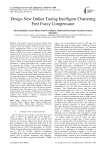
Design New Online Tuning Intelligent Chattering Free Fuzzy Compensator
Статья научная
This research is focused on proposed adaptive fuzzy sliding mode algorithms with the adaptation laws derived in the Lyapunov sense. The stability of the closed-loop system is proved mathematically based on the Lyapunov method. Adaptive MIMO fuzzy compensate fuzzy sliding mode method design a MIMO fuzzy system to compensate for the model uncertainties of the system, and chattering also solved by new adaption method. Since there is no tuning method to adjust the premise part of fuzzy rules so we presented a scheme to online tune consequence part of fuzzy rules. Classical sliding mode control is robust to control model uncertainties and external disturbances. A sliding mode method with a switching control low guarantees the stability of the certain and/or uncertain system, but the addition of the switching control low introduces chattering into the system. One of the main targets in this research to reduce or eliminate chattering is to insert online tuning method. Classical sliding mode control method has difficulty in handling unstructured model uncertainties. One can overcome this problem by combining a sliding mode controller and artificial intelligence (e.g. fuzzy logic). To approximate a time-varying nonlinear dynamic system, a fuzzy system requires a large amount of fuzzy rule base. This large number of fuzzy rules will cause a high computation load. The addition of an adaptive law to a fuzzy sliding mode controller to online tune the parameters of the fuzzy rules in use will ensure a moderate computational load. The adaptive laws in this algorithm are designed based on the Lyapunov stability theorem. Asymptotic stability of the closed loop system is also proved in the sense of Lyapunov. This method is applied to continuum robot manipulator to have the best performance.
Бесплатно
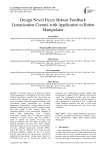
Design Novel Fuzzy Robust Feedback Linearization Control with Application to Robot Manipulator
Статья научная
First three degree of six degree of freedom robotic manipulator is controlled by a new fuzzy sliding feedback linearization controller. The robot arm has six revolute joints allowing the corresponding links to move horizontally. When developing a controller using conventional control methodology (e.g., feedback linearization methodology), a design scheme has to be produced, usually based on a system’s dynamic model. The work outline in this research utilizes soft computing applied to new conventional controller to address these methodology issues. Feedback linearization controller (FLC) is influential nonlinear controllers to certain systems which this method is based on compute the required arm torque using nonlinear feedback control law. When all dynamic and physical parameters are known FLC works superbly; practically a large amount of systems have uncertainties and fuzzy feedback linearization controller (FFLC) reduce this kind of limitation. Fuzzy logic provides functional capability without the use of a system dynamic model and has the characteristics suitable for capturing the approximate, varying values found in a MATLAB based area. To increase the stability and robustness new mathematical switching sliding mode methodology is applied to FFLC. Based on this research model free mathematical tunable gain new sliding switching feedback linearization controller applied to robot manipulator is presented to have a stable and robust nonlinear controller and have a good result compared with conventional and pure fuzzy logic controllers.
Бесплатно
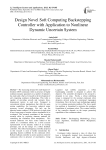
Статья научная
The increasing demand for multi-degree-of-freedom (DOF) continuum robot in presence of highly nonlinear dynamic parameters in a number of industries has motivated a flurry of research in the development of soft computing nonlinear methodology. This robot is capable of providing smooth and isotropic three-dimensional motion in each joint. Compared to conventional robotic manipulators that offer the same motion capabilities, the innovative spherical motor possesses several advantages. Not only can the spherical motor combine 3-DOF motion in a single joint, it has a large range of motion with no singularities in its workspace. This research contributes to the on-going research effort by exploring alternate methods for controlling the continuum robot manipulator. This research addresses two basic issues related to the control of a continuum robots; (1) a more accurate representation of the dynamic model of an existing prototype, and (2) the design of a robust feedback controller. The robust backstepping controller proposed in this research is used to further demonstrate the appealing features exhibited by the continuum robot. Robust feedback controller is used to position control of continuum robot in presence of uncertainties. Using Lyapunov type stability arguments, a robust backstepping controller is designed to achieve this objective. The controller developed in this research is designed in two steps. Firstly, a robust stabilizing torque is designed for the nominal continuum robot dynamics derived using the constrained Lagrangian formulation. Next, the fuzzy logic methodology applied to it to solution uncertainty problem. The fuzzy model free problem is formulated to minimize the nonlinear formulation of continuum robot. The eventual stability of the controller depends on the torque generating capabilities of the continuum robots.
Бесплатно
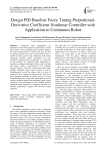
Статья научная
Continuum robot manipulators are optimized to meet best trajectory requirements. Closed loop control is a key technology that is used to optimize the system output process to achieve this goal. In order to conduct research in the area of closed loop control, a control oriented cycle-to-cycle continuum robot model, containing dynamic model information for each individual continuum robot manipulator, is a necessity. In this research, the continuum robot manipulator is modeled according to information between joint variable and torque, which is represented by the nonlinear dynamic equation. After that, a multi-input-multi-output baseline computed torque control scheme is used to simultaneously control the torque load of system to regulate the joint variables to desired levels. One of the most important challenge in control theory is on-line tuning therefore fuzzy supervised optimization is used to tune the modified baseline and computed torque control coefficient. The performance of the modified baseline computed torque controller is compared with that of a baseline proportional, integral, and derivative (PID) controller.
Бесплатно
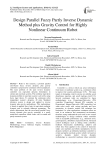
Статья научная
Refer to this research, a position parallel error-based fuzzy inverse dynamic plus gravity controller is proposed for continuum robot manipulator. The main problem of the pure inverse dynamic controller was equivalent dynamic formulation in certain and uncertain systems. The nonlinear equivalent dynamic problem in uncertain system is solved by using fuzzy logic theory. To estimate the continuum robot manipulator system’s dynamic, 49 rules Mamdani inference system is design and applied to inverse dynamic plus gravity methodology. This methodology is based on applied fuzzy logic in equivalent nonlinear dynamic part to estimate unknown parameters. The results demonstrate that the error-based parallel fuzzy inverse dynamic plus gravity controller is a partly model-free controllers which works well in certain and partly uncertain system.
Бесплатно
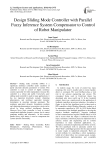
Статья научная
Sliding mode controller (SMC) is a significant nonlinear controller under condition of partly uncertain dynamic parameters of system. This controller is used to control of highly nonlinear systems especially for robot manipulators, because this controller is a robust and stable. Conversely, pure sliding mode controller is used in many applications; it has two important drawbacks namely; chattering phenomenon, and nonlinear equivalent dynamic formulation in uncertain dynamic parameter. The nonlinear equivalent dynamic formulation problem and chattering phenomenon in uncertain system can be solved by using artificial intelligence theorem. However fuzzy logic controller is used to control complicated nonlinear dynamic systems, but it cannot guarantee stability and robustness. In this research parallel fuzzy logic theory is used to compensate the system dynamic uncertainty.
Бесплатно
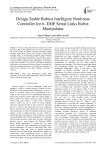
Design Stable Robust Intelligent Nonlinear Controller for 6- DOF Serial Links Robot Manipulator
Статья научная
In this research parallel Proportional-Derivative (PD) fuzzy logic theory plus Integral part (I) is used to compensate the system dynamic uncertainty controller according to highly nonlinear control theory sliding mode controller. Sliding mode controller (SMC) is an important considerable robust nonlinear controller. In presence of uncertainties, this controller is used to control of highly nonlinear systems especially for multi degrees of freedom (DOF) serial links robot manipulator. In opposition, sliding mode controller is an effective controller but chattering phenomenon and nonlinear equivalent dynamic formulation in uncertain dynamic parameters are two significant drawbacks. To reduce these challenges, new stable intelligent controller is introduce.
Бесплатно
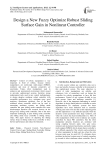
Design a New Fuzzy Optimize Robust Sliding Surface Gain in Nonlinear Controller
Статья научная
Control of robotic manipulator is very important in field of robotic, because robotic manipulators are multi-input multi-output (MIMO), nonlinear and most of dynamic parameters are uncertainty. Today, robot manipulators used in unknown and unstructured environment which caused to provides sophisticated systems, therefore strong mathematical tools used in new control methodologies to design adaptive nonlinear robust controller with acceptable performance (e.g., minimum error, good trajectory, disturbance rejection). One of the best nonlinear robust controller which can be used in uncertainty nonlinear systems, are sliding mode controller but pure sliding mode controller has some disadvantages therefore this research focuses on the design fuzzy sliding mode controller. One of the most important challenging in pure sliding mode controller and sliding mode fuzzy controller is sliding surface slope. This paper focuses on adjusting the sliding surface slope in sliding mode fuzzy controller to have the best performance and reduce the limitation.
Бесплатно
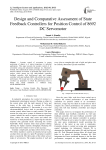
Статья научная
Accurate control of servomotor in proper positioning of objects is of utmost importance in industrial applications. This paper presents the position control of dc servomotor using pole placement technique via Ackerman’s formula. The mathematical model governing the dynamics of brush dc Pittman servomotor is developed and is then used to analyze which among the full state-feedback controller, feedback controller with feed-forward gain and integral controller with state feedback (SFB) will yield the best control performance. The steady state error, settling time and degree of overshoot are parameters on which the performance level is based. The whole simulation is validated using MATLAB/SIMULINK.
Бесплатно
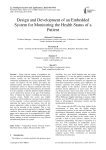
Design and Development of an Embedded System for Monitoring the Health Status of a Patient
Статья научная
Along with the ageing of population, the low cost and high efficiency physiological information monitor systems for the realization of long-term community guardianship are of great significance. This system can improve the life quality and reduce the medical expense. Our paper is a working model which incorporates sensors to measure parameters like body temperature, heart beat rate, blood pressure; and transfer it to the computer so that the patient’s health condition can be analyzed by doctors in any part of the hospital. Thus, it reduces the doctor’s workload and also gives accurate results. Further this system uses Zigbee technology which enables the viewing of all parameters on the computer. A micro-controller board is used for analyzing the inputs from the patient. Also all the process parameters within an interval selectable by the user can be recorded on the computer. This is very useful for future analysis and review of patient’s health condition. For more versatile medical applications, this paper can be improvised, by incorporating ECG, EMG, EEG systems, dental sensors and annunciation systems, thereby making it useful in hospitals as a very efficient and dedicated patient care system.
Бесплатно
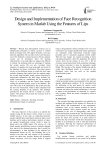
Design and Implementation of Face Recognition System in Matlab Using the Features of Lips
Статья научная
Human Face Recognition systems are an identification procedure in which a person is verified based on human traits. This paper describes a fast face detection algorithm with accurate result. Lip Tracking is one of the biometric systems based on which a genuine system can be developed. Since the uttering characteristics of an individual are unique and difficult to imitate, lip tracking holds an advantage of making the system secure. We use pre- recorded visual utterance of speakers has been generated and stored in the database for future verification. The entire project occurs in four different stages in which the first stage includes obtaining face region from the original image, the second stage includes mouth region extraction by background subtraction, the third stage includes key points extraction by considering the lip centroid as origin of co-ordinates and the fourth stage includes storing the obtained feature vector in the database. The user who wants to be identified by the system provides the new live information, which is then compared with the existing template in the database. The feedback provided by the system will be ‘a match or a miss-match’. This project will increase the accuracy level of biometric systems.
Бесплатно
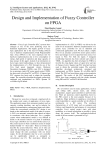
Design and Implementation of Fuzzy Controller on FPGA
Статья научная
Fuzzy Logic Controller (FLC) systems have emerged as one of the most promising areas for Industrial Applications. The highly growth of fuzzy logic applications led to the need of finding efficient way to hardware implementation. Field Programmable Gate Array (FPGA) is the most important tool for hardware implementation due to low consumption of energy, high speed of operation and large capacity of data storage. In this paper, instead of an introduction to fuzzy logic control methodology, we have demonstrated the implementation of a FLC through the use of the Very high speed integrated circuits Hardware Description Language (VHDL) code. FLC is designed for an armature control DC motor speed control. VHDL has been used to develop FLC on FPGA. A Sugeno type FLC structure has been used to obtain the controller output. The controller algorithm developed synthesized, simulated and implemented on FPGA Spartan 3E xc3s500e-4fg320 board.
Бесплатно
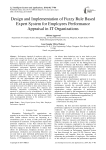
Статья научная
Performance Appraisal of employees plays a very critical role towards the growth of any organization. It has always been a tough task for any industry or organization as there is no unanimous scientific modus operandi for that. Performance Appraisal system is used to assess the capabilities and productiveness of the employees. In assessing employee performance, performance appraisal commonly includes assigning numerical values or linguistic labels to employees performance. However, the employee performance appraisal may include judgments which are based on imprecise data particularly when one employee tries to interpret another employee’s performance. Thus, the values assigned by the appraiser are only approximations and there is inherent vagueness in the evaluation. By fuzzy logic perspective, the performance of the appraisee includes the evaluation of his/her work ability, skills and adaptability which are absolutely fuzzy concepts that needs to be define in fuzzy terms. Hence, fuzzy approach can be used to examine these imprecise and uncertainty information. Consequently, the performance appraisal of employees can be accomplished by fuzzy logic approach and different defuzzification techniques are applied to rank the employees according to their performance, which shows inconsequential deviation in the rankings and hence proves the robustness of the system.
Бесплатно
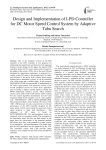
Статья научная
One of the modified versions of the PID controller is the I-PD controller. It was proposed for eliminating the proportional and derivative kick appeared during set point change. In this paper, the optimal I-PD controller design for DC motor speed control system by the adaptive tabu search (ATS), one of the most efficient metaheuristic optimization techniques, is proposed. In a control system, DC motor is the principle and it is widely used because of the power from existing direct-current lighting power distribution systems. It can be controlled over a wide range and a variable supply. In this research, TMS320F28335 DSP microcontroller is implemented for DC motor speed control. This processor consists of the several peripheral circuits for motor drive application such as analog to digital, encoder digital to analog and PWM input/output interface circuits. These interface circuits can be used in both of DC and AC motor controls. For the control algorithm development and the Code Composer Studio (CCS) compiler can be used together with TMS320F28335 DSP in MATLAB/SIMULINK. This proposed method is tested with the DC motor, 1260, 1400, 1540 rpm and 24 volts, consecutively to verify the performance of the I-PD controller designed for DC motor speed control system using the speed and control signal response to many load disturbances. The simulation of DC motor is based on MATLAB/SIMULINK. The implementation results are compared with the simulation results. The correlation in the experiment shows that they are high related. In this paper show the effectiveness of the proposed methods and discuss how they could generalize to other systems by the simulation and experimentation. The results show that the I-PD parameters can be optimized by the ATS. The controlled system with I-PD provides better responses once compared to that with a basic parallel PID controller.
Бесплатно
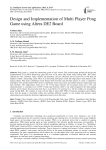
Design and Implementation of Multi Player Pong Game using Altera DE2 Board
Статья научная
Pong game is a simple but entertaining game of logic control. This research paper presents the design and implementation of an FPGA-based Pong game that runs on an Altera DE2 board using Verilog HDL. This article explains the VGA controller, object creation and animation, and text subsystem and of course how to link them all together to build a functioning circuit. There is an interesting multi-player mode and single-player mode feature in this design scheme. This game's multiplayer mode features both real-time and automatic players to create a competitive atmosphere. This design method followed less complicated, fastest processing, and utilized memory requirements and logic elements. The single-player mode uses 1.3% of total logic elements, the two-player mode uses 1.32%, and automatic player vs. real player uses 1.456% of total logic elements which is very small compared to the other gaming schemes and it reduces the processing time that is cost-effective for universal use. All the modules are designed by using Verilog HDL. The synthesis is done with the help of Altera DE2 FPGA. Functional simulation and synthesis prove that the design is universally usable and combines different modules in one module that presents sound entertainment and extends the electronics application-based work in the future.
Бесплатно
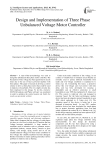
Design and Implementation of Three Phase Unbalanced Voltage Motor Controller
Статья научная
A state-of-the-art-technology was used to design the unbalanced three phase motor controller. The fluctuation of line voltage has been questioned in recent times due to the use of heavy powered machine with three phases. This paper is focused on deriving a control scheme to drive a three phase motor that could be used in industry or households. The very simple circuitry has been employed in this design. To do this, extensive MATLAB analysis and PSpice software was conducted in order to optimize the control system and finally the results are practically verified.
Бесплатно

